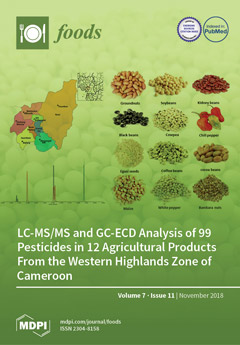Arthrobacter arilaitensis is a food-related bacterial species under investigation for its involvement in the coloration of surface-ripened cheeses. Presently, information about this species in association with the development of appropriate cheese coloration is still lacking. This study was performed in order to investigate—with
[...] Read more.
Arthrobacter arilaitensis is a food-related bacterial species under investigation for its involvement in the coloration of surface-ripened cheeses. Presently, information about this species in association with the development of appropriate cheese coloration is still lacking. This study was performed in order to investigate—with the use of spectrocolorimetry—the influence of pH, NaCl, and deacidifying yeasts on the pigmentation of
Arthrobacter arilaitensis biofilms. Three types of cheese-based (curd) solid media were prepared by using different deacidification methods: (i) chemical deacidification by NaOH (CM
NaOH); (ii) biological deacidification by the yeast strain
Debaryomyces hansenii 304 (CM
Dh304); and (iii) biological deacidification by the yeast strain
Kluyveromyces marxianus 44 (CM
Km44). Each medium was prepared with initial pH values of 5.8, 7.0, and 7.5. After pasteurization, agar was incorporated and NaCl was added in varying concentrations (0%, 2%, 4%, and 8% (w/v)).
A. arilaitensis Po102 was then inoculated on the so prepared “solid-curd” media, and incubated at 12 °C under light conditions for 28 days. According to the data obtained by spectrocolorimetry in the Compagnie Internationale de l’Eclairage (CIE)
L*
a*
b* color system, all controlled factors appeared to affect the pigments produced by the
A. arilaitensis strain. NaCl content in the media showed distinct inhibitory effects on the development of color by this strain when the initial pH was at 5.8. By contrast, when the initial pH of the media was higher (7.0, 7.5), only the highest concentration of NaCl (8%) had this effect, while the coloring capacity of this bacterial species was always higher when
D. hansenii 304 was used for deacidification compared to
K. marxianus 44.
Full article






